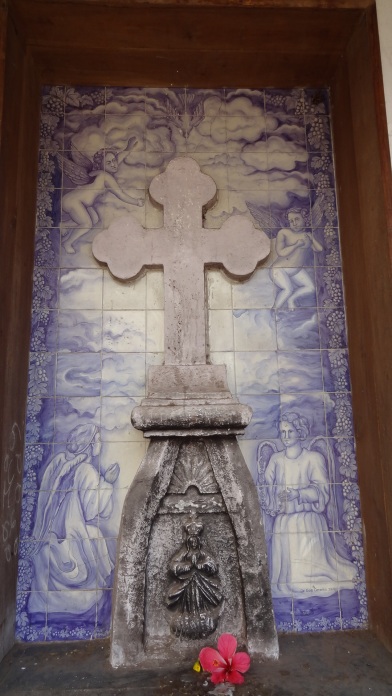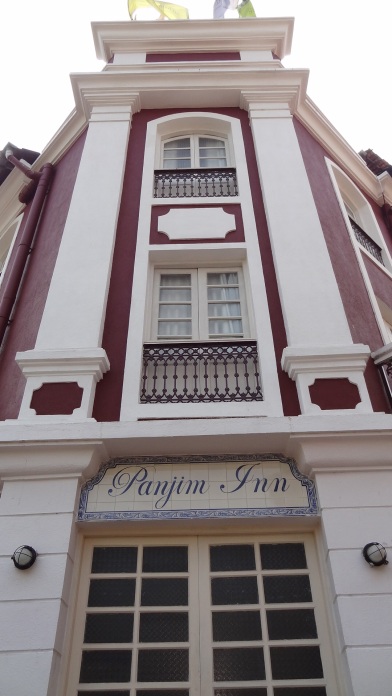… that you get a certain type of pretty, blue tile that is known as ‘Azulego’ in Goa? I did not, till I read up a little bit about Goa for our recent trip there. One of Goa’s lesser known aspects, for sure. Unfortunately, as it turned out later, my research proved to be inadequate.

The word ‘azulego’ has been derived from the Arabic word ‘zellige’, which means ‘polished stone’. The Moors – Muslim inhabitants of Morocco, Sicily, Malta, Western Sahara and Western Algeria – began the art of hand-painting polished tiles. This art form spread to places like Spain, Portugal, Germany and Holland in the 16th century. The Portuguese improvised the technique of making these tiles, and began predominantly using the colour blue in them. When this art form became popular in Portugal, these tiles began to be used everywhere – on the walls of houses, on the floors, in churches, in restaurants and trains, as well as in other public places. Major historic events began to be depicted on these tiles, too. The tiles not only provided ornamental value, but also helped keep the temperature under control. These blue tiles are still widely used in Portugal, apparently, albeit in contemporary forms.


When the Portuguese came to Goa, in the 1500s, they brought with them this form of making tiles as well. Today, in Goa, these tiles are mostly used to add an element of style, in a nameplate for a home or the frame for a mirror, or are sold as souvenirs. There are several contemporary art galleries in Goa, particularly in Panjim, which sell these tiles. We saw these tiles used at several places in Goa, in the homes of people, outside churches, on roadside altars and in restaurants, and they look absolutely gorgeous.


We got so tired and hungry just driving around Panjim and photographing the beautiful old buildings there that, sadly, we didn’t get a chance to stop by a gallery and buy some of these tiles as souvenirs. It took us close to 3 hours to find Fontainhas, which is supposed to be the manufacturing hub of these beautiful tiles. No one we asked could guide us correctly. When we finally reached Fontainhas, all we found were shops and art galleries and narrow, narrow, narrow lanes. We wanted to buy the tiles directly from a potter’s place, but we didn’t find any such. All the galleries we came across looked very elegant-looking and seemed to be expensive places to shop.
Next time, I’m going to buy some for sure. I have heard a lot of awesome things about Fontainhas, and want to explore it in a much better way the next time around. And, next time, I’m going to go to Goa better informed.
Any suggestions on where to buy some azulegos in Goa are most welcome!
Hey TGND most of the govt crafts stores stock these in readymade sizes, with pictures of goa, or typical designs and mario miranda replicas. They usually take orders for specific things, but those take time to be made (sometimes even 10-15 days). I know a couple fo good places that make them very well. Have gifted name plates and trays made of them to friends. The next time you visit, let me know in advance, I can order what you want in advance, so it can be ready to be picked by the time your holiday is done.
I am in Bangalore at the moment. If I had seen this earlier, I could have carried some back with me this time 🙂
LikeLike
@Haathi
Awww, thank you so much for the offer. I missed the opportunity. 😦
The next time, will definitely let you know. 🙂
LikeLike
Yes, it definitely looks a bit Portugese! I once said I wanted Portugese tiles in my bathroom, but it hasn’t happened yet. Perhaps instead of going all the way to Portugal I can more easily pop over to Goa and take advantage of the link. It would add an extra bit of story to the history of the tradition!
LikeLike
@Bronwyn Joy
Definitely! You could get some from Goa – Fontainhas, particularly. 🙂
LikeLike
Noted! Thanks.
LikeLike
@Bronwyn Joy
You’re welcome! 🙂
LikeLike
I had no clue about this *goes off to check with Appa*
LikeLike
@R’s Mom
Let me know what your Appa says, okie? 🙂
LikeLike
I did visit Velha Goa as we were staying very close to it…almost walking distance from the place.I did buy a Mario Miranda framed tile from there.Rest were too expensive.I bought some smaller painted tiles from the Govt craft shops.
LikeLike
@Antara
Sounds lovely! I didn’t know there were government craft shops there, too. In Panjim, you mean?
LikeLike